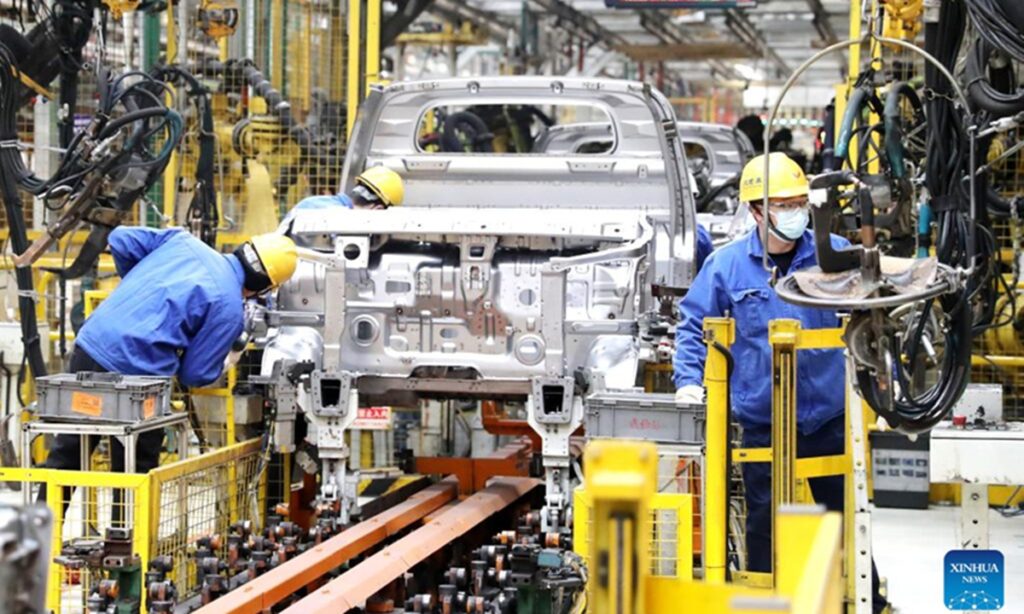US efforts to “decouple” from China will soon see China account for less than half of the US’ low-cost imports from Asian countries for the first time in more than a decade, according to the latest data from the Chicago-based management consulting firm Kearney, the Financial Times reported on Sunday.
According to the Kearney Reshoring Index, last year, Chinese goods made up 50.7 percent of US manufactured imports from Asian countries, down from nearly 70 percent in 2013.
The Kearney data, to a certain extent, reflects trends in China-US trade and the US “decoupling” push that is trying to use Vietnam and other Asian countries to replace China’s role in its supply chains. If anything, it could serve as another reminder to China as to the urgency of speeding up the upgrading of the country’s industrial chain, accelerating independent innovation and developing high-end manufacturing.
While a continued “decoupling” trend doesn’t look favorable for Chinese exports, there is no need to be too pessimistic as it doesn’t represent the overall picture of Chinese manufacturing. It is true that due to China-US trade friction, global pandemic and other external shocks, the traditional comparative advantages of China’s manufacturing sector, which are mainly centered on low-cost labor force, have gradually weakened, leading to the shift of some low-end industrial sector to Southeast Asia in recent years.
Yet, even though the US’ low-cost imports have increased sourcing from other Asian countries and reduced procurement from China, the machines that make these low-end products, such as sewing machines, textile machinery, processing machinery, electronic equipment, and others, may still need to rely on supplies from China. Indeed, China’s foreign trade figures are the most direct evidence supporting such dependence and the resilience of Chinese manufacturing.
According to the latest statistics from the General Administration of Customs, Chinese exports to ASEAN in yuan terms jumped 24.1 percent year-on-year in the first four months of this year, much higher compared with the overall export growth of 10.6 percent, while exports to India rose 12.8 percent during the same period of time. Specifically, Chinese exports of mechanical equipment increased 15.3 percent year-on-year from January to April.
Moreover, a major change occurring across Chinese manufacturing is that high-value-added production capacity is rising rapidly, with high-end products such as new energy vehicles, high-speed rail, and electronic equipment gradually gaining foothold in the global markets. In the first four months of this year, China’s automobile exports surged 120.3 percent year-on-year, of which a major boost comes from new-energy vehicles. For instance, Tesla is reportedly listing China-made Model 3 and Model Y models for sale in Canada, according to a recent Reuters report. In addition, China’s photovoltaic industry has become a competitive one in the world, with solar panels becoming a new shining point in China’s foreign trade.
There is every reason to believe that as Chinese manufacturing continues to move up the value chain, there will be more Chinese products characterized by delivering both leading technology and price advantages. And the West may be able to resist a certain category of products for a while, but in the long run, resistance to market choice is against the rules of the market and against the interests of consumers.
Last but not least, the structural change in Chinese manufacturing is an indication of the strengthening restructuring. There is growing awareness that China cannot always stay at the low-end or rely on low prices to compete for market share. To retain its position in the global industrial chain, it needs to develop its own design and production system for its own high-end products such as the C919 aircraft.
In the end, no matter what measures the US takes, it is not the only market in the world. As long as China does a good job in transformation and upgrading, it doesn’t need to worry about where to find new markets.
In fact, American consumers are not abandoning China-made goods once and for all. In 2022, Chinese sellers regained market share they had lost on Amazon. In February 2022, Chinese sellers’ market share among top sellers on Amazon fell to 40 percent, but by December 2022, the figure had risen back to 45 percent. This fact suggests that while American consumers buy less low-end goods from China, they may still consume other Chinese goods, which also represents Chinese manufacturing.
(Global Times)




